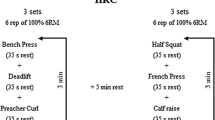Abstract
The effects of training in a hypobaric chamber on aerobic metabolism were studied in five high performance triathletes. During 3 weeks, the subjects modified their usual training schedule (approximately 30 h a week), replacing three sessions of bicycling exercise by three sessions on a cycle ergometer in a hypobaric chamber simulating an altitude of 4,000 m (462 mm Hg). Prior to and after training in the hypobaric chamber the triathletes performed maximal and submaximal exercise in normoxia and hypoxia (462 mm Hg). Respiratory and cardiac parameters were recorded during exercise. Lactacidaemia was measured during maximal exercise. Blood samples were drawn once a week to monitor blood cell parameters and erythropoetin concentrations. Training in the hypobaric chamber had no effect on erythropoiesis, the concentrations of erythropoetin always remaining unchanged, and no effect on the maximal oxygen uptake (\(\dot V\)O2max) and maximal aerobic capacity measured in normoxia or hypoxia. Submaximal performance increased by 34% during a submaximal exhausting exercise performed at a simulated altitude of 2,000 m. During a submaximal nonexhausting test, ventilation values tended to decrease for similar exercise intensities after training in hypoxia. The changes in these parameters and the improved performance found for submaximal exercise may have been the result of changes taking place in muscle tissue or the result of training the respiratory muscles.
Similar content being viewed by others
References
Asano K, Sub S, Matsuzaka A, Hirakoba K, Nagai J, Kawaoka T (1986) The influence of simulated high altitude training on work capacity and performance in middle and long distance runners. Bull Health and Sports Sci 9:195–202
Berglund B (1992) High altitude training. Aspects of haematological adaptation. Sports Med 14:289–303
Bouissou P (1987) L'entrainement en altitude. In:Bouissou P, Peronnet F, Guezennec CY, Richalet JP (eds) Performance et entrainement en altitude. Vigot, Lausanne, pp 85–101
Boutellier U, Piwko P (1992) The respiratory system as an exercise limiting factor in normal sedentary subjects. Eur J Appl Physiol 64:145–152
Boutellier U, Büchel Ramon, Kundert Andreas, Spengler Christina (1992) The respiratory system as an exercise limiting factor in normal trained subjects. Eur J Appl Physiol 65:347–353
Buskirk ER, Kollias J, Akers RF, Prokop KE, Picon-Reategui E (1967) Maximal performance at altitude and on return from altitude in conditioned runners. J Appl Physiol 23:259–266
Cerretelli P (1981) Energy metabolism during exercise and altitude. In: Di Prampero PE, Poortmans JR (eds) Exercise and environment. Medicine sport 13. Karger, Basel, pp 175–190
Consolazio CF, Nelson RA, Matoush LO, Hansen JE (1966) Energy metabolism at high altitude (3475 m). J Appl Physiol 21:1732–1740
Daniels J, Oldridge N (1970) The effects of alternate exposure to altitude and sea level on world-class middle-distance runners. Med Sci Sports 2:107–112
Eckardt KU, Boutellier U, Krutz A, Schopen M, Koller EA, Bauer C (1989) Rate of erythropoietin formation in humans in response to acute hypobaric hypoxia. J Appl Physiol 66:1785–1788
Eckardt KU, Kurtz A, Bauer C (1990) Triggering of erythropoietin production by hypoxia is inhibited by respiratory and metabolic acidosis. Am J Physiol 258:R678-R683
Faulkner JA, Daniels JT, Balke B (1967) Effects of training at moderate altitude on physical performance capacity. J Appl Physiol 23:85–88
Fry RW, Morton AR, Keast D (1991) Overtraining in athletes. Sports Med 12:32–65
Gleser MA, Vogel JA (1973) Effects of acute alterations in VO2 max on endurance capacity of men. J Appl Physiol 34:443–447
Hansen JE, Gerald SP, Stelter J, Vogel AJ (1967) Arterial pyruvate, lactate, pH and CO2 during work at sea level and high altitude. J Appl Physiol 23:523–530
Jansson E, Terrados N, Norman B, Kaijser L (1992) Effects of training at simulated high altitude on exercise at sea level. Scand J Med Sci Sports 2:2–6
Kasalicky J, Ressl J, Urbanova D, Widimsky J, Ostadal B, Pelouch V, Vizek M, Prochazka J (1977) Relative organ blood flow in rats exposed to intermittent high altitude hypoxia. Pflügers Arch 368:111–115
Kollias J, Buskirk ER (1974) Exercise and altitude In: Johnson, Buskirk ER (eds) Structural and physiological aspects of exercise and sport. Princeton, N.J., pp 211–227
Knaupp W, Khilnani S, Sherwood J, Scharf S, Steinberg H (1992) Erythropoietin response to acute normobaric hypoxia in humans. J Appl Physiol 73:837–840
Lawler J, Powers SK, Thompson D (1988) Linear relationship between VO2max and VO2max decrement during exposure to acute hypoxia. J Appl Physiol 64:1486–1492
Maher JT, Jones LG, Hartley LH, Williams GH, Rose LI (1975) Aldosterone dynamics during graded exercise at sea level and high altitude. J Appl Physiol 39:18–22
Rahn H, Otis AB (1949) Man's respiratory response during and after acclimatization to high altitude. Am J Physiol 157:445–462
Roskamm H, Landry F, Samek L, Schlager M, Weidemann H, Reindell H (1969) Effects of standardized ergometer training program at three different altitudes. J Appl Physiol 27:840–847
Savourey G, Garcia N, Besnard Y, Hanniquet AM, Fine MO, Bittel J (1994) Physiological changes induced by pre-adaptation to high altitude. Eur J Appl Physiol 69:221–227
Schmidt W, Eckardt KU, Hilgendorf A, Strauch S, Bauer C (1991) Effects of maximal and submaximal exercise under normoxic and hypoxic conditions on serum erythropoietin level. Int J Sports Med 12:457–461
Spengler CM, Roos M, Laube S, Boutellier U (1994) Respiratory endurance training increases exercise endurance and reduces blood lactate accumulation in healthy subjects. Eur J Appl Physiol 69:S13
Terrados N, Melichna J, Sylven C, Jansson E, Kaijser L (1988) Effects of training at simulated altitude on performance and muscle metabolic capacity in competitive road cyclists. Eur J Appl Physiol 57:203–209
Terrados N, Jansson E, Sylven C, Kaijser L (1990) Is hypoxia a stimulus for synthesis of oxidative enzymes and myoglobin? J Appl Physiol 68:2369–2372
Author information
Authors and Affiliations
Rights and permissions
About this article
Cite this article
Vallier, J.M., Chateau, P. & Guezennec, C.Y. Effects of physical training in a hypobaric chamber on the physical performance of competitive triathletes. Europ J Appl Physiol 73, 471–478 (1996). https://doi.org/10.1007/BF00334426
Accepted:
Issue Date:
DOI: https://doi.org/10.1007/BF00334426




